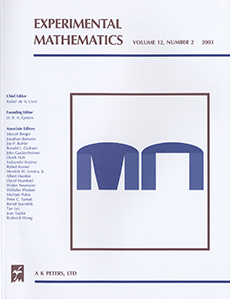Abstract
Let $f(2,3,4)$} denote the smallest integer $n$ such that there exists a l$K_4$}-free graph of order $n$ for which any $2$-coloring of its edges yields at least one monochromatic triangle. It is well known that such a number must exist. For a long time, the best known upper bound, provided by J. Spencer, was $f(2,3,4)$ < 3 \cdot 10^9. Recently, L. Lu announced that $f(2,3,4)$ < 10,000. In this note, we will give a computer-assisted proof showing that $f(2,3,4)$ < 1000. To prove this, we will generalize an idea of Goodman's, giving a necessary and sufficient condition for a graph $G$ to yield a monochromatic triangle for every edge coloring.
Citation
Andrzej Dudek. Vojtĕech Rödl. "On the Folkman Number ${f(2,3,4)}$." Experiment. Math. 17 (1) 63 - 67, 2008.
Information




